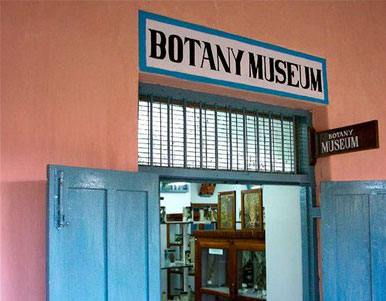Photos – Botany Museum Photos
The present outstanding status of Botany Museum is due to the outcome of strenuous work of the past 50 years. The introduction of COSIP-UGC Programme has helped in expanding the museum on all dimensions.

Botany museum is housed in a large hall of 1000 sft. The museum part has 10 sections of an attractive central row of G.I. pipe stands with three glass-covered stages to keep the specimens mounted in glass jars. It is surrounded by a number of wooden almirahs fitted with glass doors to display specimens mounted in glass jars, models, Physiology apparatus, fossils etc., Some of the models and framed Photographs and pictures are displayed on the walls.
Most of the specimens in the museum are collected during Various Botanical tours by the staff and students of Botany department. Very rare specimens like marine algae from Krusadii island, Cornivorous plants from Assam, Dawsonia, Glossopteris and Phylloglossum from Australia and Bryophytes of IOWA (U.S.A.) donated by Ratna Kumar are special attraction to the museum. Framed herbarium sheets of valuable plants collected from different parts of India are displayed. A number of local plants having medicinal importance are mounted in glass jars with their Botanical, Vernacular and sanskrit names identified as per Dhanvanthari Nighantuvu. Other important economic plant products like Cereals, Pulses, Spices, Fruits, Vegetables etc., are displayed as a part of the academic curriculum.

The various items in the museum are categorized to 18 units in order to make it convenient to explain them to students as a part of the academic curriculum. The entire material related to the museum was compiled in the form of a book to enable the staff as ready reckoner.
The Herbarium and flora part of the museum is housed in a separate hall of 500 sft. which is adjacent to the existing museum.
The collection of local plants under ‘Flora of Bhimavaram’ by Sri R.P.Rama Rao was identified upto species level with authentified identification from central National Herbarium, Calcutta, keep open the doors for enterprising research scholars to visit D.N.R.College herbarium room and derive the benefit. In the herbarium room about 104 photographs of different plants and 70 frames of herbarium sheets of local plants have been displayed to enable the students to become familiar with flora.
Academicians and the top brass of Central and State government visited the museum and paid rich encomiums.